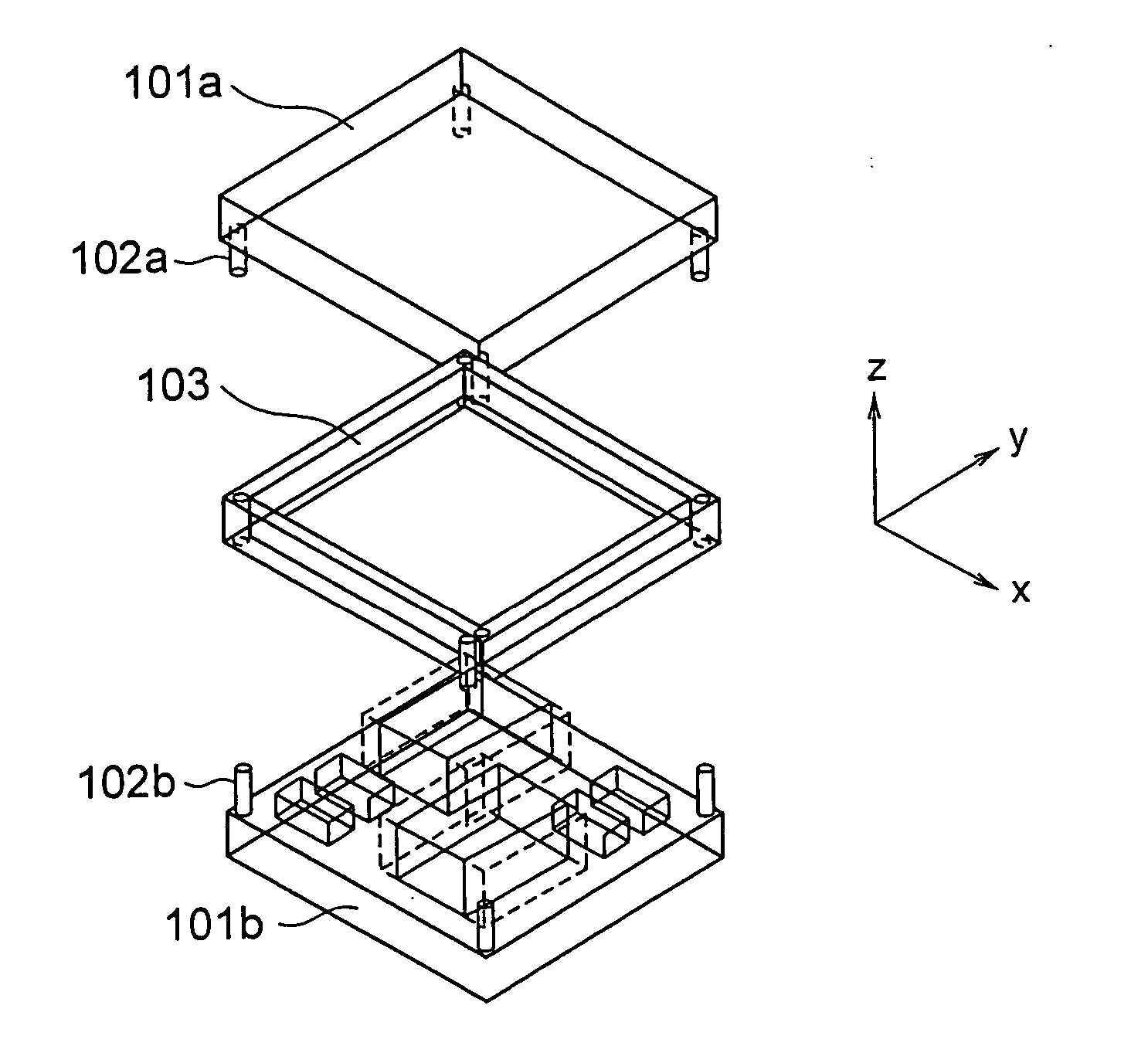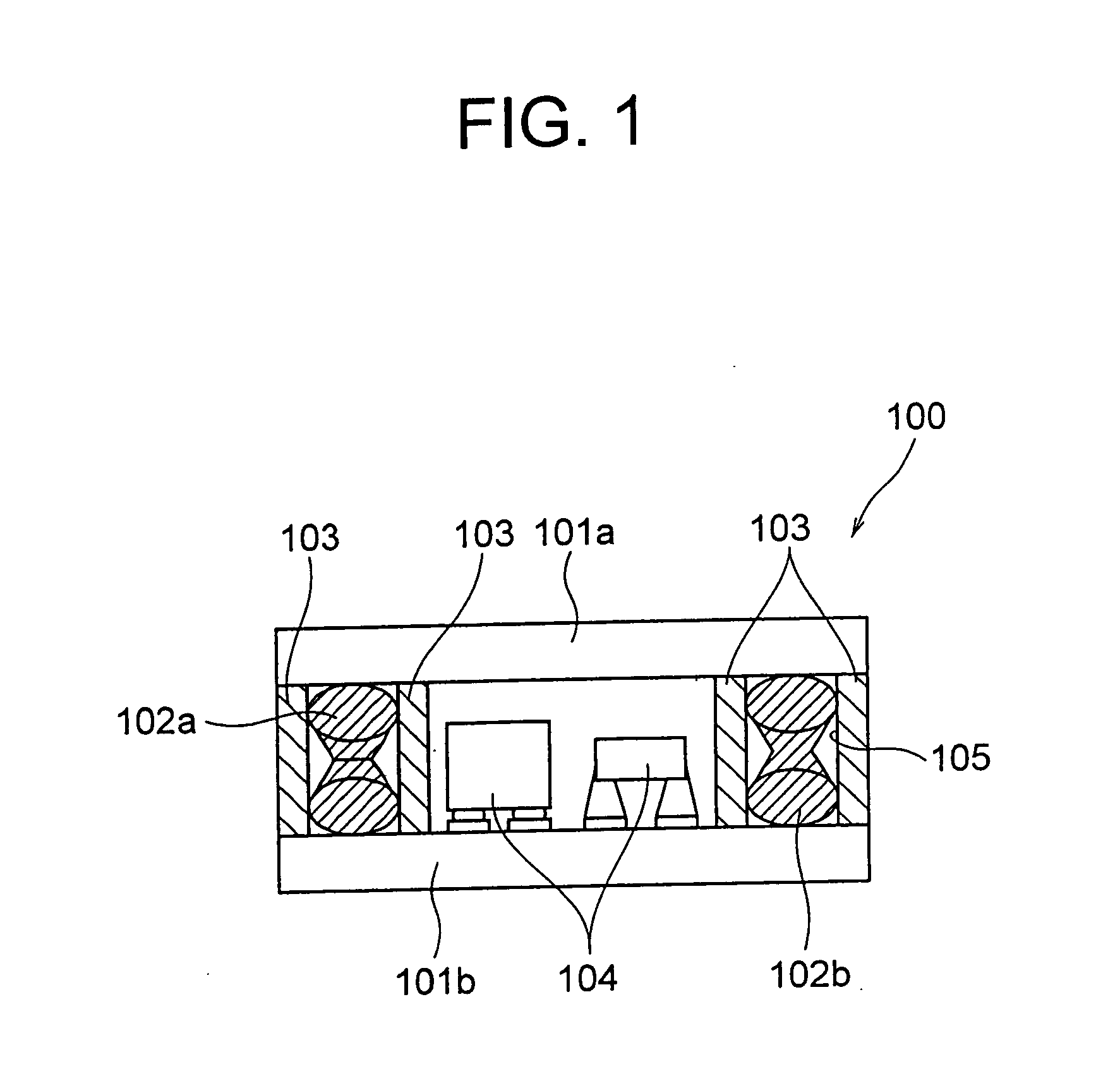Stacked mounting structure
a mounting structure and stacked technology, applied in the direction of microstructural devices, printed circuit aspects, stacked spaced pcbs, etc., can solve the problems of high degree of difficulty in mounting, difficult to deal with automatic packaging machines, and the job of disposing and soldering, so as to reduce the projected area, reduce the size, and improve the yield
- Summary
- Abstract
- Description
- Claims
- Application Information
AI Technical Summary
Benefits of technology
Problems solved by technology
Method used
Image
Examples
first embodiment
[0047] A stacked mounting structure 100 according to a first embodiment of the present invention will be described below. FIG. 1 shows a cross-sectional view of the stacked mounting structure 100. FIG. 2 shows a perspective view of the disassembled stacked mounting structure 100.
[0048] In FIG. 1, each of a first substrate 101a and a second substrate 101b is in a flat plate form. A substrate such as an organic substrate, a ceramic substrate, a glass substrate, a Si substrate, a metal substrate, and a flexible substrate can be used for these two substrates 101a and 101b. Moreover, it is also possible to use a composite material substrate in which these substrates are combined. The first substrate 101a corresponds to a first member. The second substrate 101b corresponds to a second member.
[0049] A term substrate is used for the sake of convenience. However, without restricting to the substrate, the present invention is similarly applicable to any member which forms a mounting structu...
second embodiment
[0078] Next, a stacked mounting structure 200 according to a second embodiment will be described below. FIG. 3 shows a cross-sectional view of a state before joining the stacked mounting structure 200. Same reference numerals are assigned to components which are same as in the first embodiment, and repeated description is omitted.
[0079] In the second embodiment, as shown in FIG. 3, a height of the first protruding electrode 102a is Ha and a height of the second protruding electrode 102b is Hb, and a combined height Ha+Hb which is a total of the two heights Ha and Hb is more than a height Hc of the intermediate substrate 103. At the same time, each of the first protruding electrode 102a and the second protruding electrode 102b has a shape in which a front end is the narrowest.
[0080] In other words, the heights Ha and Hb of the first protruding electrode 102a and the second protruding electrode 102b respectively, and the height Hc (thickness) of the intermediate electrode 103 satisf...
third embodiment
[0086] Next, a stacked mounting structure 300 according to a third embodiment of the present invention will be described below. FIG. 4 shows a cross-sectional view of a state before joining the stacked mounting structure 300. Same reference numerals are assigned to components which are same as in the first embodiment, and the repeated description is omitted.
[0087] In the third embodiment, as shown in FIG. 4, in a state before joining each member, a maximum diameter Wa of the first protruding electrode 102a and the second protruding electrode 102b is smaller than a diameter Wc of the opening 105 in the intermediate substrate 105.
[0088] In other words, the maximum diameter Wa of the first protruding electrode 102a and the second protruding electrode 102b, and the diameter Wc of the opening in the intermediate substrate 103 satisfy the following equation (2).
Wc>Wa (2)
[0089] Next, an action of the third embodiment will be described below. By satisfying the equation (2), it is possibl...
PUM
 Login to View More
Login to View More Abstract
Description
Claims
Application Information
 Login to View More
Login to View More - R&D
- Intellectual Property
- Life Sciences
- Materials
- Tech Scout
- Unparalleled Data Quality
- Higher Quality Content
- 60% Fewer Hallucinations
Browse by: Latest US Patents, China's latest patents, Technical Efficacy Thesaurus, Application Domain, Technology Topic, Popular Technical Reports.
© 2025 PatSnap. All rights reserved.Legal|Privacy policy|Modern Slavery Act Transparency Statement|Sitemap|About US| Contact US: help@patsnap.com



